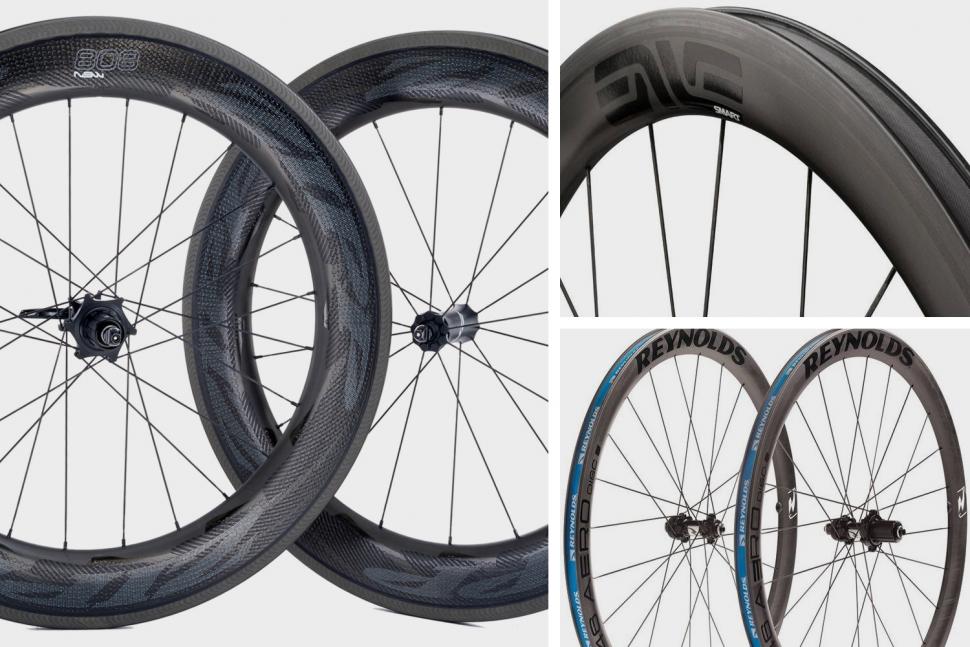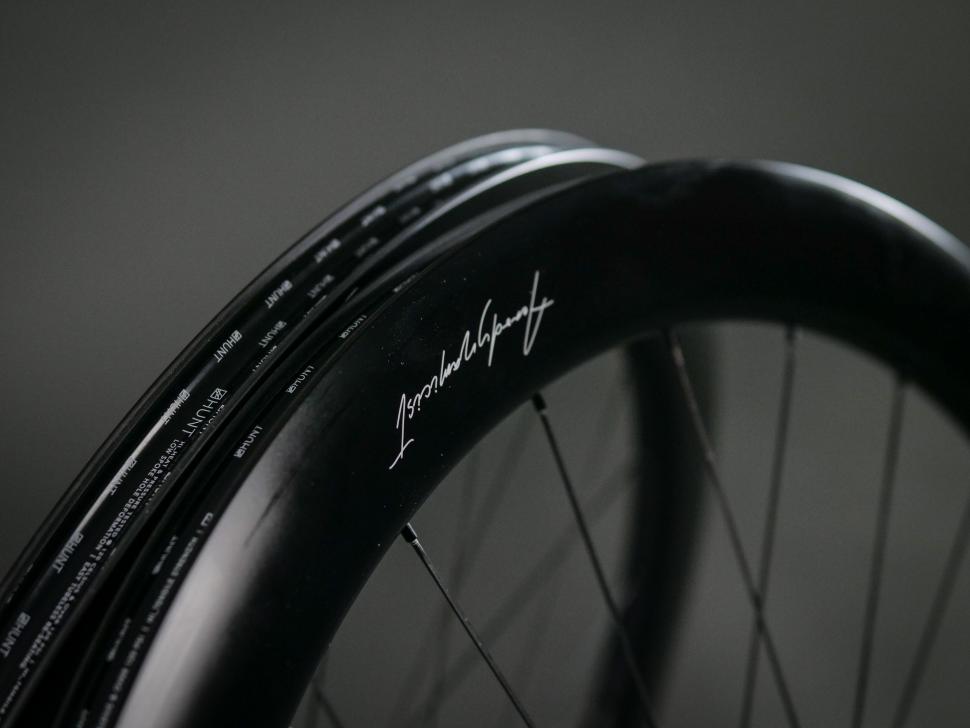- News
- Reviews
- Bikes
- Accessories
- Accessories - misc
- Computer mounts
- Bags
- Bar ends
- Bike bags & cases
- Bottle cages
- Bottles
- Cameras
- Car racks
- Child seats
- Computers
- Glasses
- GPS units
- Helmets
- Lights - front
- Lights - rear
- Lights - sets
- Locks
- Mirrors
- Mudguards
- Racks
- Pumps & CO2 inflators
- Puncture kits
- Reflectives
- Smart watches
- Stands and racks
- Trailers
- Clothing
- Components
- Bar tape & grips
- Bottom brackets
- Brake & gear cables
- Brake & STI levers
- Brake pads & spares
- Brakes
- Cassettes & freewheels
- Chains
- Chainsets & chainrings
- Derailleurs - front
- Derailleurs - rear
- Forks
- Gear levers & shifters
- Groupsets
- Handlebars & extensions
- Headsets
- Hubs
- Inner tubes
- Pedals
- Quick releases & skewers
- Saddles
- Seatposts
- Stems
- Wheels
- Tyres
- Health, fitness and nutrition
- Tools and workshop
- Miscellaneous
- Tubeless valves
- Buyers Guides
- Features
- Forum
- Recommends
- Podcast
feature
 The pros and cons of carbon fibre wheels April 2019
The pros and cons of carbon fibre wheels April 2019Should you buy carbon fibre wheels? What are they best for?
Do you need carbon fibre wheels? Wheels make a huge difference to how a bike rides and feels, and carbon fibre wheels have become very popular in the last decade. But are they just for professional bike racers?
All the pros race on carbon fibre wheels these days, and they’ve even replaced the traditional aluminium wheels for races like Paris-Roubaix and Tour of Flanders, the last outpost for aluminium rims in the professional racing world. It's a long time since the Tour de France was won on an aluminium wheelset.
- Buyer's Guide to road bike wheels, plus eight of the best
They’re popular outside of the professional circuit, though, with more amateur racers and sportive cyclists making the upgrade. That has been helped by growing choice and a lot more affordable options in the past few years. Manufacturers have ironed out most of the problems that afflicted early carbon fibre wheels. Reliability is much improved and clever coatings on the brake track mean rim-brake carbon wheels actually stop in the wet now. With the rise of disc brakes you can swerve that whole issue of course.
With carbon fibre wheels a desirable upgrade, we look at the pros and cons.
Pros: Aero, lightweight and cool looks
Aerodynamic benefits. The biggest appeal of upgrading to a carbon fibre wheel is the aerodynamic advantage over a box section aluminium rim. There is plenty of wind tunnel data (if you want to believe it) from the leading manufacturers showing that carbon wheels reduce drag significantly. If you’re racing, whether against the clock in a time trial, or in a road race, carbon deep section wheels will make a noticeable difference at higher speeds.
- Reynolds aero expert Paul Lew talks wheel dynamics
Lightweight. Building a deep section rim in aluminium results in a very heavy wheel; back in the early 2000s, for example, Campagnolo offered Shamal wheels with 38mm rims that weighed 1,950g. Carbon is simply much lighter and is the reason it's the material of choice for aero wheels. The lightest carbon fibre wheels have tubular rims, and can be exceptionally light: Lightweight does a set that are 940g for the pair! If you’re a climber and want your bike to be as light as possible, carbon fibre tubulars are the way to go, provided you’re happy to glue your tyres to the rims. The stiffness to weight ratio is also better than aluminium wheels.
Ride quality and performance. Good carbon fibre wheels can transform the ride of a bike. Stiffness is greater than an aluminium wheelset so for powerful riders, sprinting and out-of-the-saddle climbing, this attribute can make a clear difference to how the bike feels, with a more responsive nature. Some carbon fibre wheels also provide a smoother ride over rough road surfaces as well.
They look cool. Don't underestimate how important this is. You’ve got to admit, there’s just something undeniably appealing about the way a sleek road bike looks when rolling on a pair of deep section carbon wheels. While many might not admit it, many invest in carbon wheels mainly because of the appearance.
Cons: Braking, expensive and durability
Braking performance. Or lack of. Early carbon fibre wheels were pretty dire when it came to stopping, but manufacturers have engineered their way out of those early problems. Much of the problem had to do with heat buildup. A problem for early carbon wheels, great improvements have been made with managing heat, from the type of resins and carbon-specific brake blocks used. The latest carbon fibre wheels now offer a big improvement in braking performance compared to those early designs. Still, a good aluminium rim provides better performance, especially in the rain. Aluminium deals with braking heat well, carbon doesn't so well.
However, the rise of disc brakes has made this yesterday's problem, provided of course you have a disc-brake-equipped bike. Without a brake track, rims can be made a little lighter too.
Weight. While carbon fibre tubular wheels might appeal to weight weenies, the fact is that the cheaper and more common carbon fibre clinchers are typically the same weight, or heavier, than a good quality aluminium wheelset. If you want the lightest wheels on a budget, then aluminium is still the way to go. The Novatec Jetfly SL wheels we tested in 2019 weighed just 1,335g yet can be found for as little as £450, cheaper than any carbon fibre wheels we're aware of. However, you do have to factor in the aerodynamic benefits of a carbon rim over an aluminium rim when comparing the weight.
Real-world aerodynamics. Manufacturers make impressive claims for the aerodynamic efficiency of carbon fibre wheels, but how that translates into the real-world with a vast range of conditions is questionable. Factors such as tyre size, frame design and wind conditions make a big impact on any claimed drag savings. Another important factor is that deep carbon rims can be very unstable in strong crosswinds, especially for lighter riders. Shallower section carbon rims (30mm) have become popular for that very reason.
Durability. Carbon is fantastically strong stuff and carbon fibre wheels can be impressively durable. They don’t bend, though, unlike aluminium, which means they can be prone to damage from sharp impacts or crashes when they’re subject to loads they’re not designed to cope with. While a bent aluminium rim can be straightened enough to get you home, it’s not the same with a carbon rim, which will most likely be a write-off. That’s why it’s always worth buying a wheel with a decent crash replacement policy.
They’re expensive. Carbon wheels ain’t cheap. They have got a lot more affordable in recent years, however: just take a look at the prices being asked by the big online retailers and you'll find plenty for well under one thousand pound mark and even some for less than £600. Yes, that’s still a lot more than most pairs of traditional aluminium wheels and you can still pay £2k+ for a set of the most advanced aero carbon wheels from the likes of Enve and Zipp.
Conclusion
So, carbon fibre wheels are clearly very popular these days, with more choice and lower prices than ever before, but there are clear pros and cons. If you’re racing and can afford them, carbon fibre wheels are easy to justify, but if you’re not racing and value durability, braking performance and affordability, there’s still life in traditional aluminium wheels yet.
Latest Comments
- chrisonabike 3 sec ago
While there are bikes (or indeed cars and the UK's "war on the driver" ha) people will leave them pretty much anywhere right by their destination....
- chrisonabike 9 min 12 sec ago
TBF the rain would be less of an issue than with rim brakes. (I guess you could argue over "modulation" though?)...
- brooksby 19 min 1 sec ago
https://www.bristolpost.co.uk/news/bristol-news/liveable-neighbourhood-o...
- slc 1 hour 48 min ago
Joking aside, governments could require new cars to be fitted with smart ignition systems that operate only for a licensed driver. No doubt there...
- wtjs 9 hours 45 min ago
There is an increasing 'disconnect' between comments in this topic and reality. Cords are either all cotton or mostly cotton and are going to last...
- ktache 10 hours 16 min ago
There are people out there who will make you the belt out of your old tyre.
- chrisonabike 10 hours 17 min ago
Furry dice and an air freshener for your helmet.
- Simon E 11 hours 5 min ago
Ah yes, those are hopefully not the 'master craftsmen' that has constructed a wide range of shoddy Italian cars and motorbikes over the years with...
- Simon E 11 hours 27 min ago
A SuperSix is definitely not an all-rounder....


Add new comment
36 comments
This is true, I also had Zipp 404 FC and it was crap... but the issue were the hubs.
Because I also tryed chinese carbon wheels 50mm with premium hubs and those wheels didn't bend at all.
I second this point. My 202s were horribly flexy climbing out of the saddle and caused constant brake rub, replaced the 177 hubs with Tune and never had any flex issues at all. Not cheap mind.
And in turn, I'd have to diasgree with your point on stiffness! At 93kg, I can get things to move without too much trouble but my Roval's don't move at all when I'm out of the saddle and i can run my back brake pretty close to the rim. My Kysriums on my winter bike flex as did my older Campag Bora 35's.
However, I'd agree with your point on the Zipps - they just seem really poorly made!
According to Velonews & Leonard Zinn, you are correct and the article explains why there is more flex in deeprim carbon wheels, not less as suggested above.
https://www.velonews.com/2018/08/from-the-mag/deep-wheels-an-engineering...
I have the best of both worlds - 20 year old Campagnolo 50mm deep rim alloy wheels. No flex, no heavier than most current carbon equivalents. Solid, bombproof, and amazing bearings.
Probably the best choice is some carbon rims with aluminium braking surface such as shimano c50. No need to change breakpads when changing wheelsets.
Of course you could go the whole hog and upgrade to discs. Let's see £1000 for half decent carb wheels a new frameset plus discs say £1500 = £2500. Personally I think that I'll stick to my Kysium Elites and SwissStop pads and spend more on cake !
Pages